Abstract
1. Mongrel dogs were anaesthetized with chloralose, paralysed, ventilated and vagotomized and given a beta-blocking drug, sotalol, in sufficient doses to block the effects of 5 microgram of adrenaline. 2. Changes in inspired CO2 concentration were produced, causing increases of arterial PCO2 up to 120 mmHg. The effects on myocardial blood flow were measured with radioactive microspheres. Coronary sinus and arterial blood was sampled. 3. In the absence of beta-blockade, an increase in arterial PCO2 produced variable effects. In some dogs coronary blood flow increased, while in others there was no change. There was a mean increase in coronary blood flow at arterial PCO2 values above 85 mmHg which was abolished by beta-blockade. 4. In the presence of beta-blockade, an increase of arterial PCO2 produced depression of left ventricular performance, i.e. a fall of maximum rate of rise of left ventricular pressure and a rise of left ventricular end-diastolic pressure. 5. In the presence of beta-blockade, there were no consistent changes in myocardial blood flow, left ventricular pressure or cardiac output. 6. In the absence of beta-blockade, coronary arterial minus venous ocygen content was reduced by hypercapnia. In the presence of beta-blockade, the changes were small and not statistically significant. The direct coronary vasodilator effect was therfore negligible. 7. It is concluded that the previously reported hypercapnic vasodilatation was mainly an effect of sympatho-adrenergic stimulation by hypercapnia. 8. In the presence of beta-blockade, coronary sinus PO2 increased markedly, with little change in coronary sinus oxygen content; this was consistent with a shift to the right of the oxy-haemoglobin dissociation curve. Under circumstances of hypercapnia, a rise in coronary sinus (and presumably tissue) PO2 failed to produce vasoconstriction. 9. It is argued that the vasodilator effect of hydrogen ions and the vasoconstrictor effect of oxygen probably cancel one another when the arterial PCO2 is raised.
Full text
PDF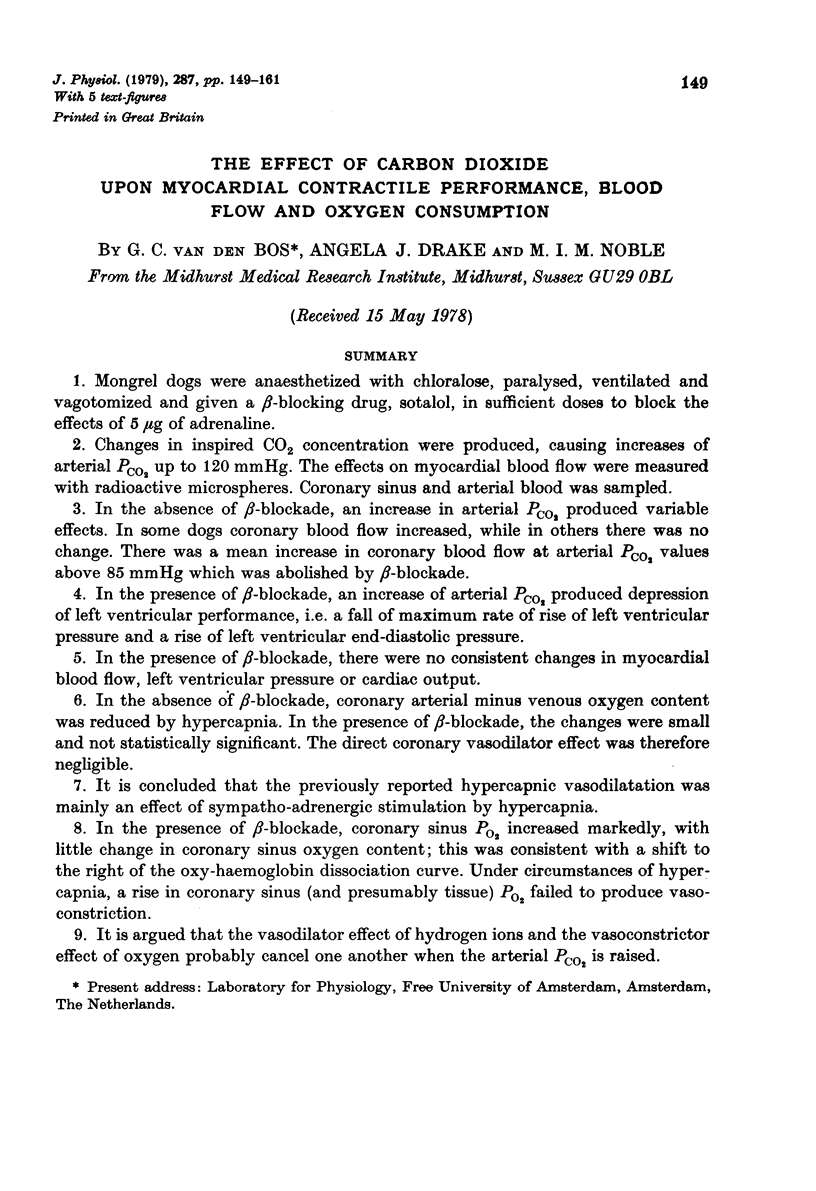
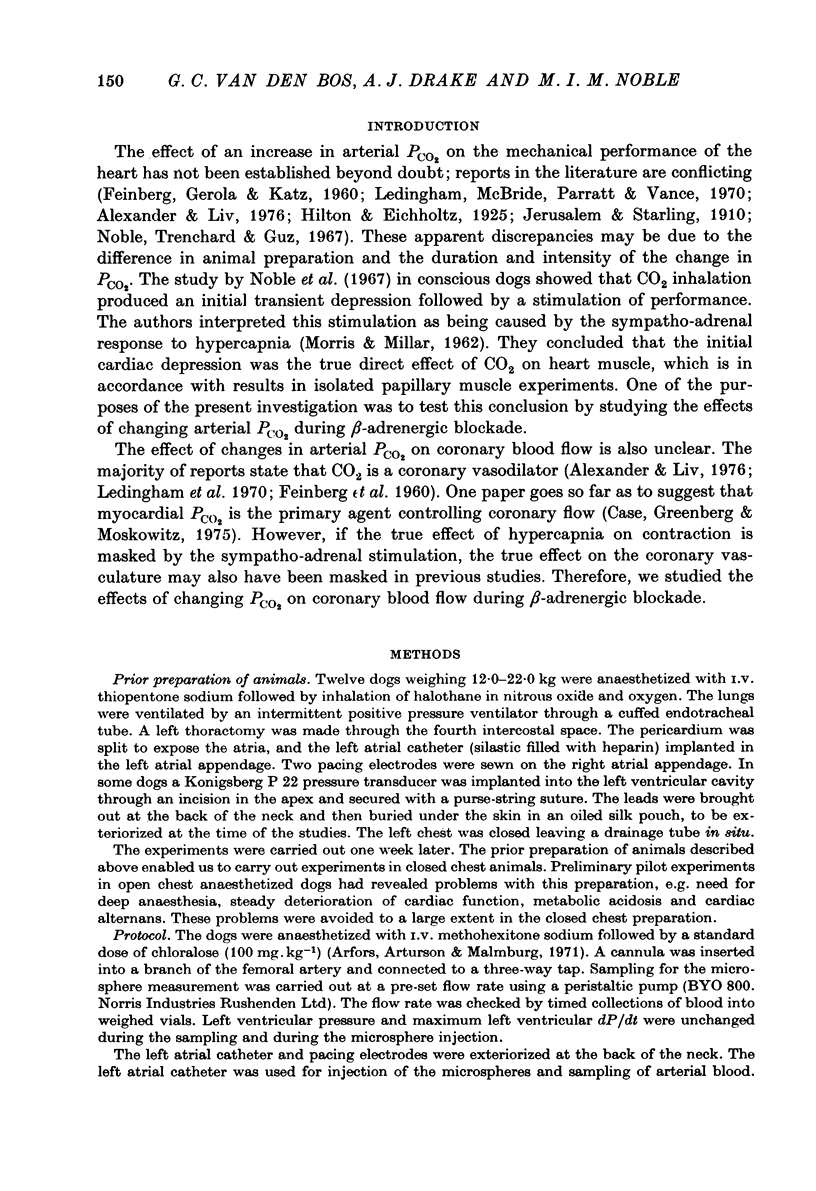
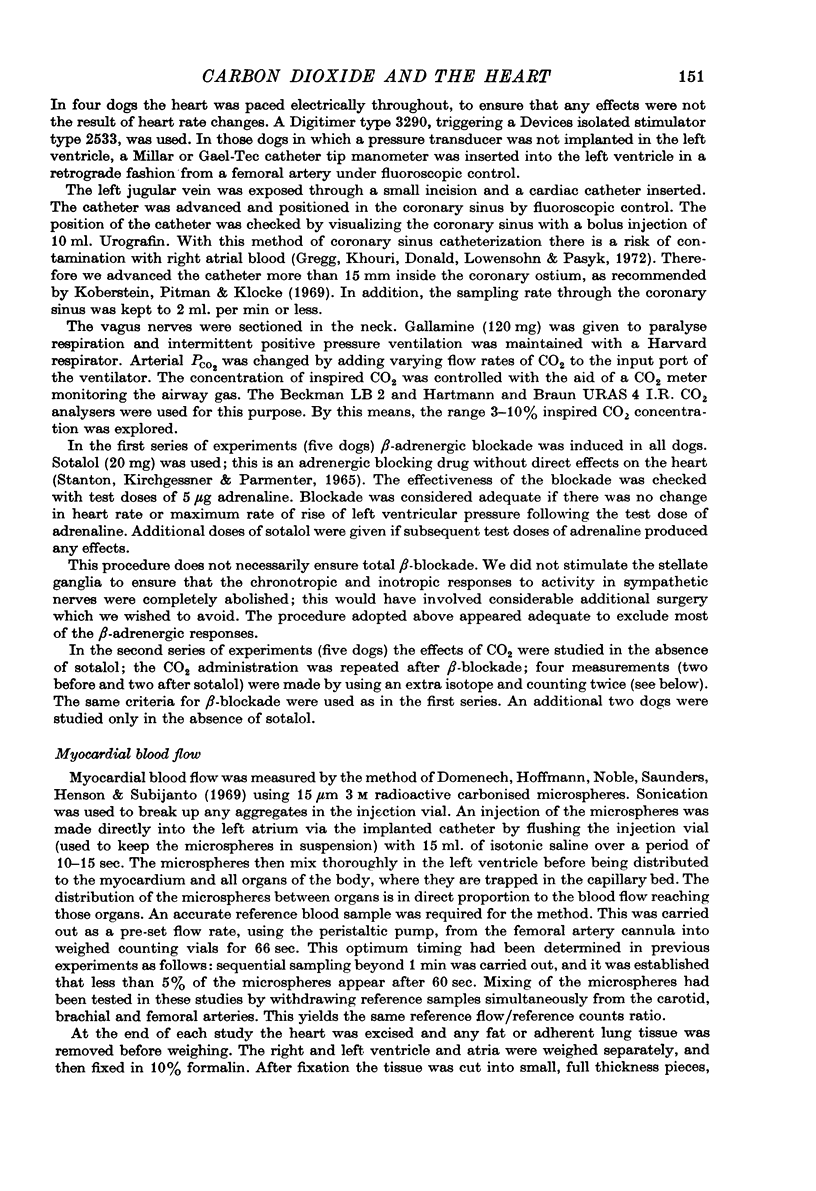
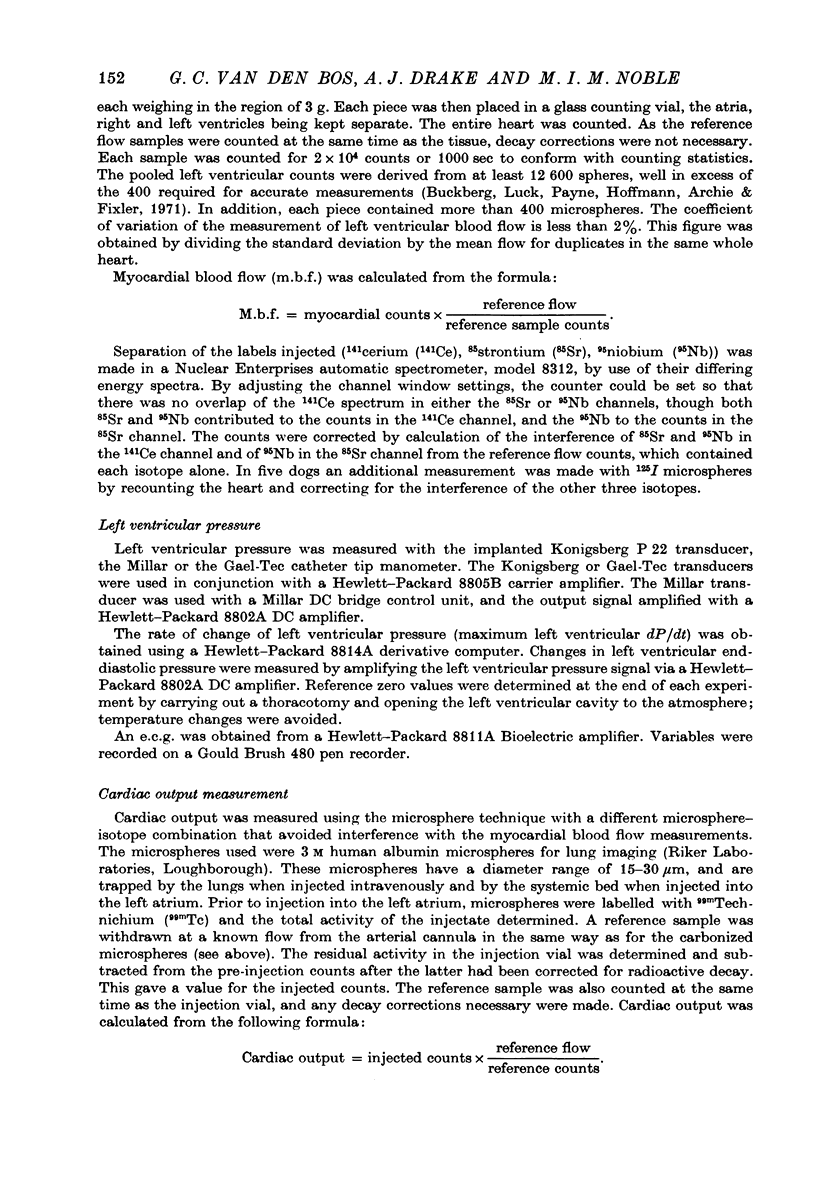
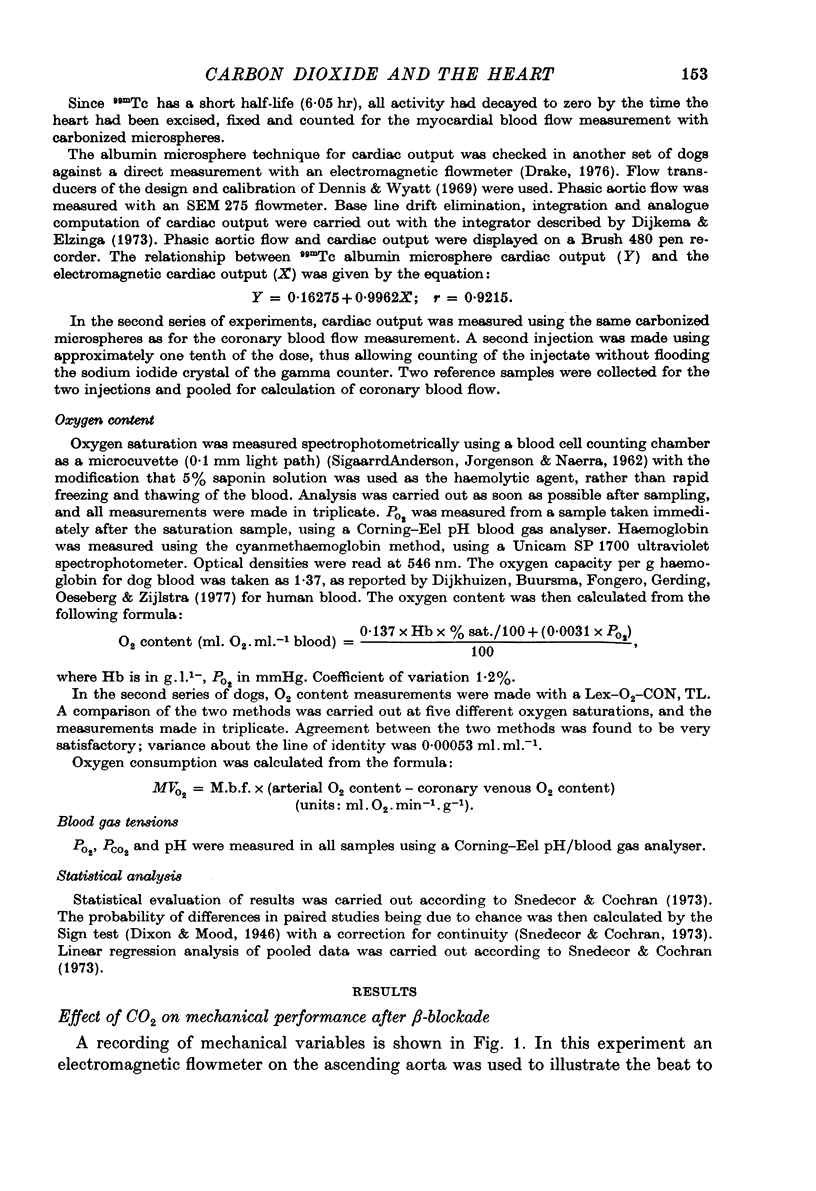

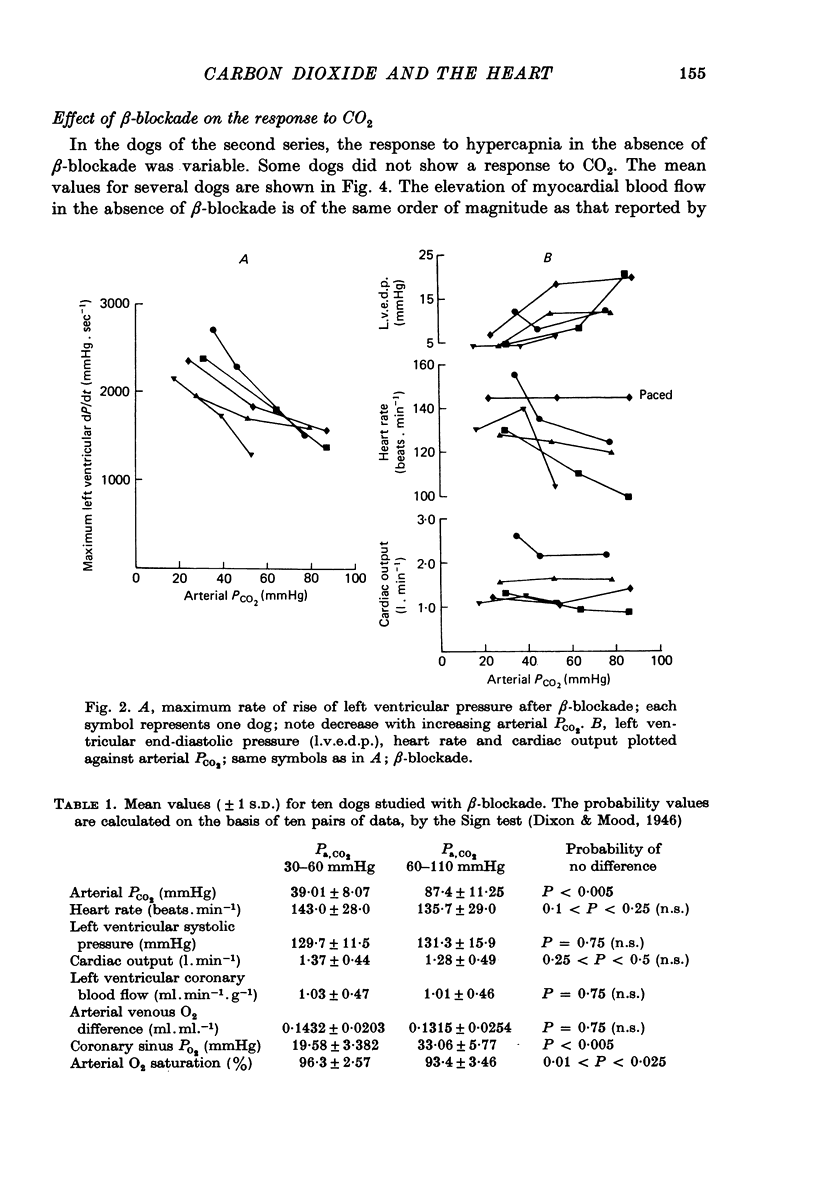
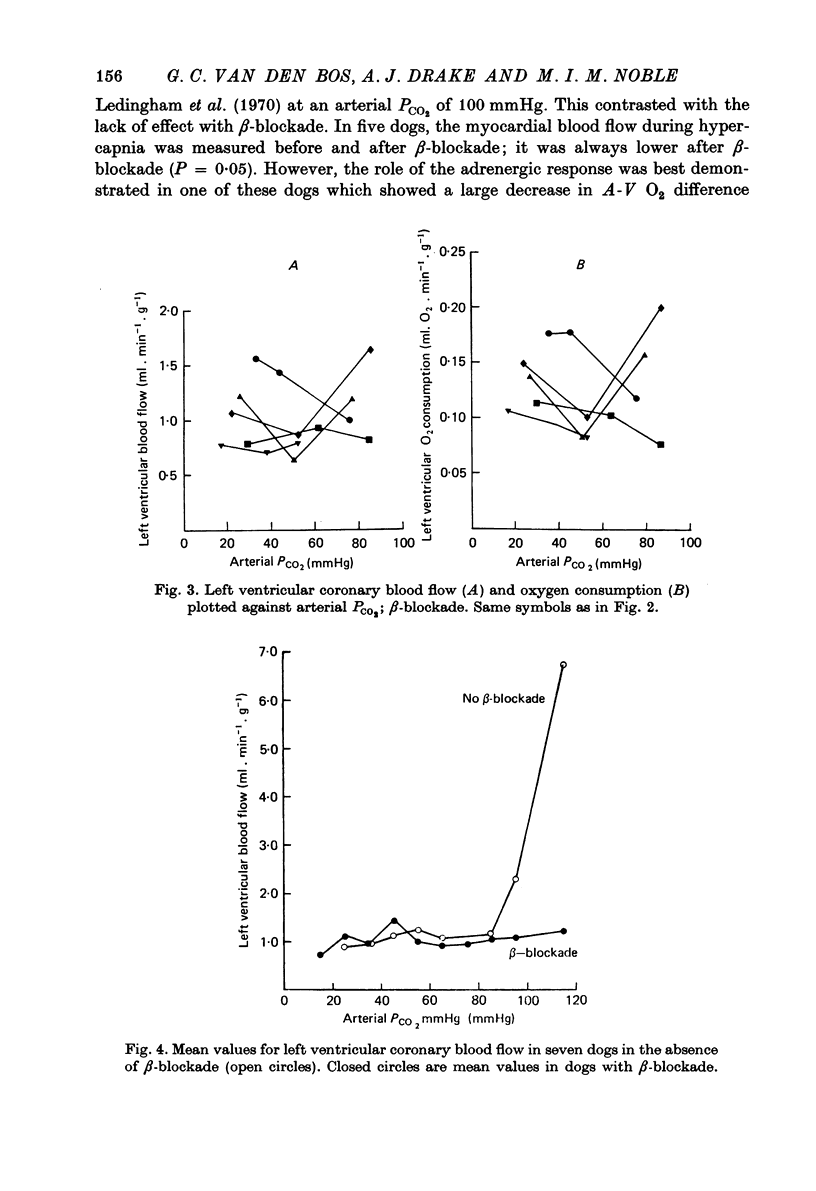

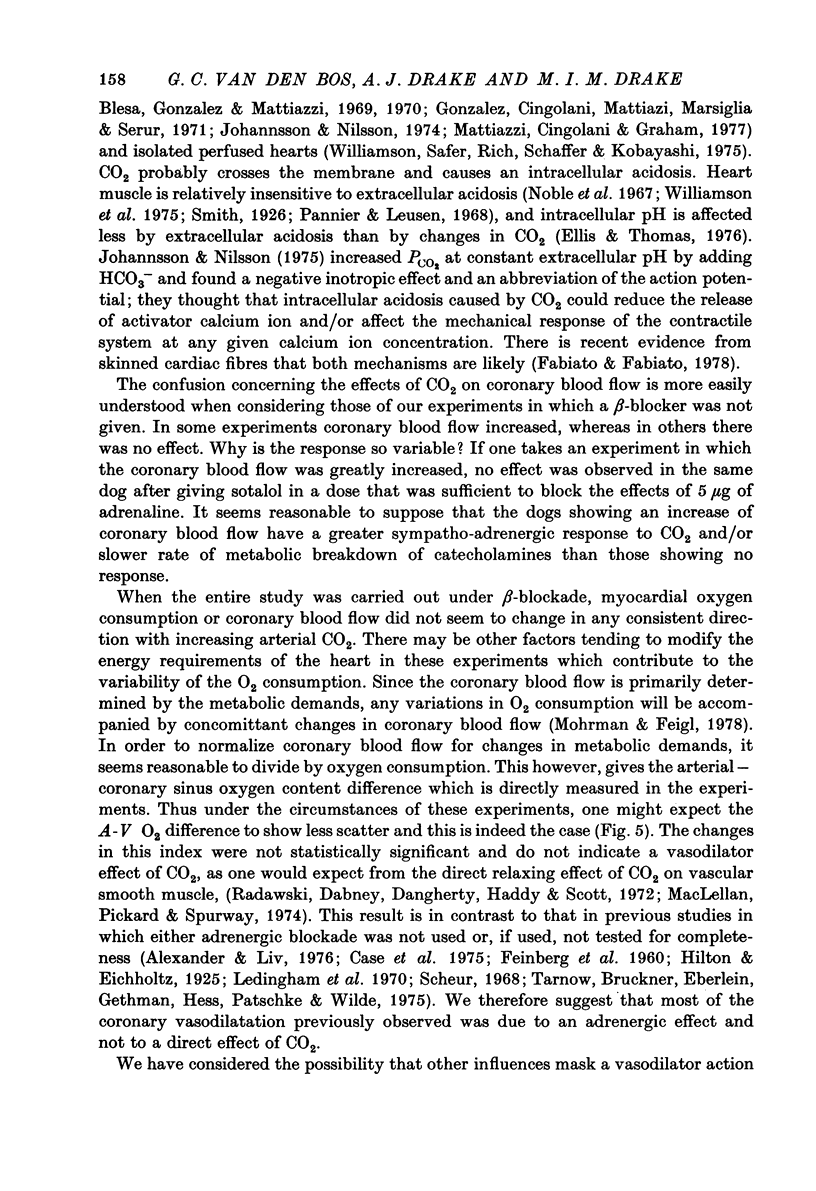
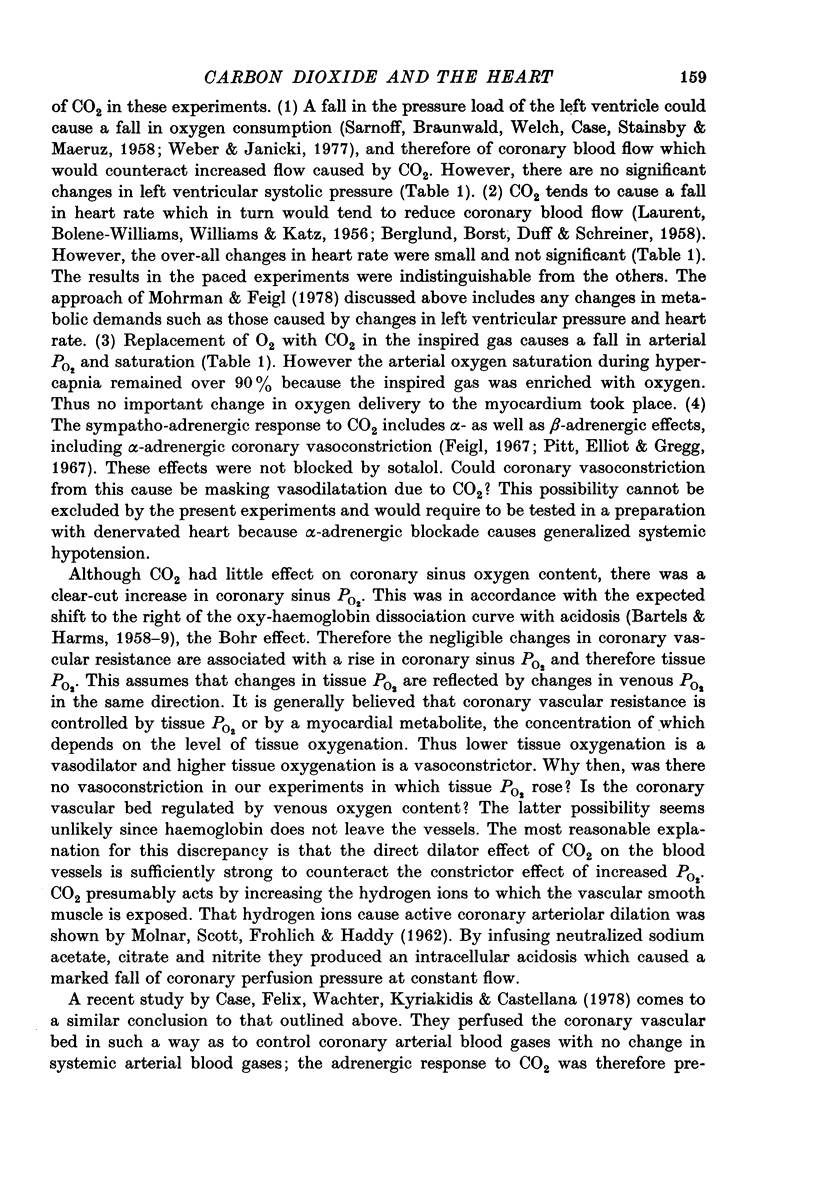
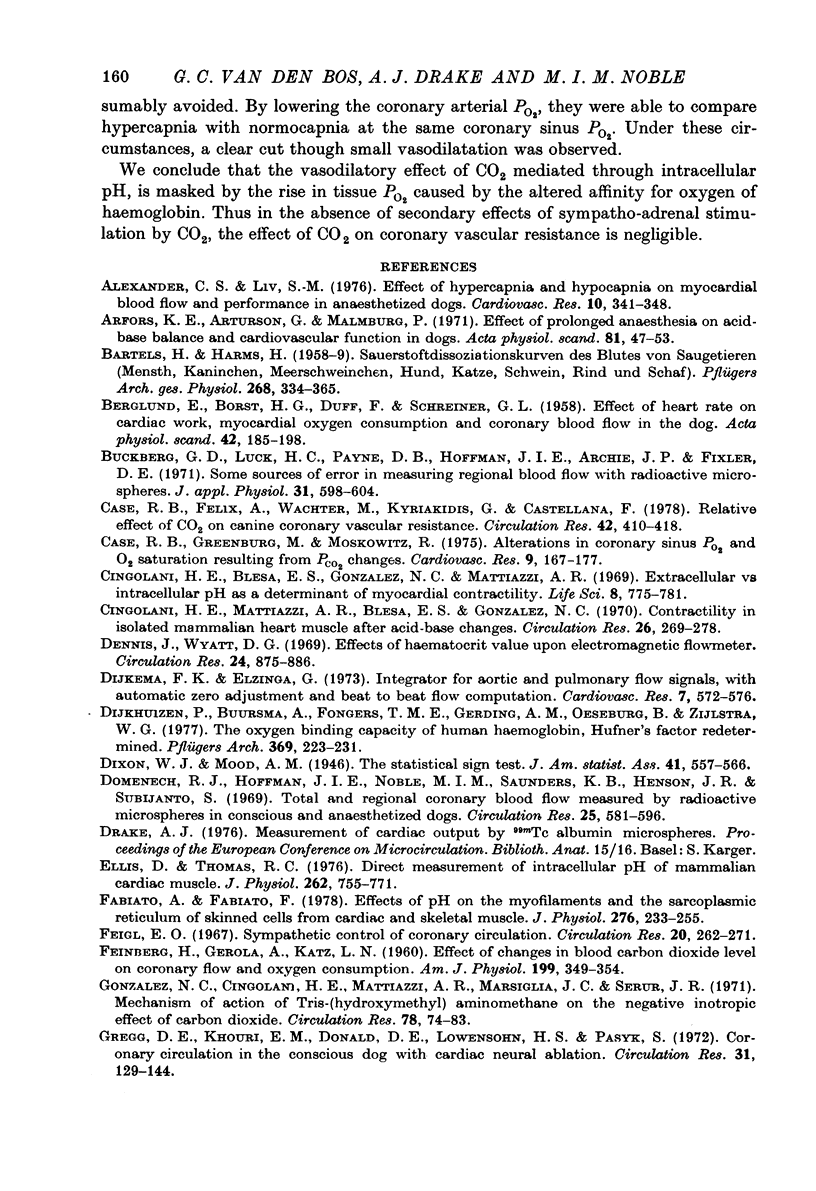
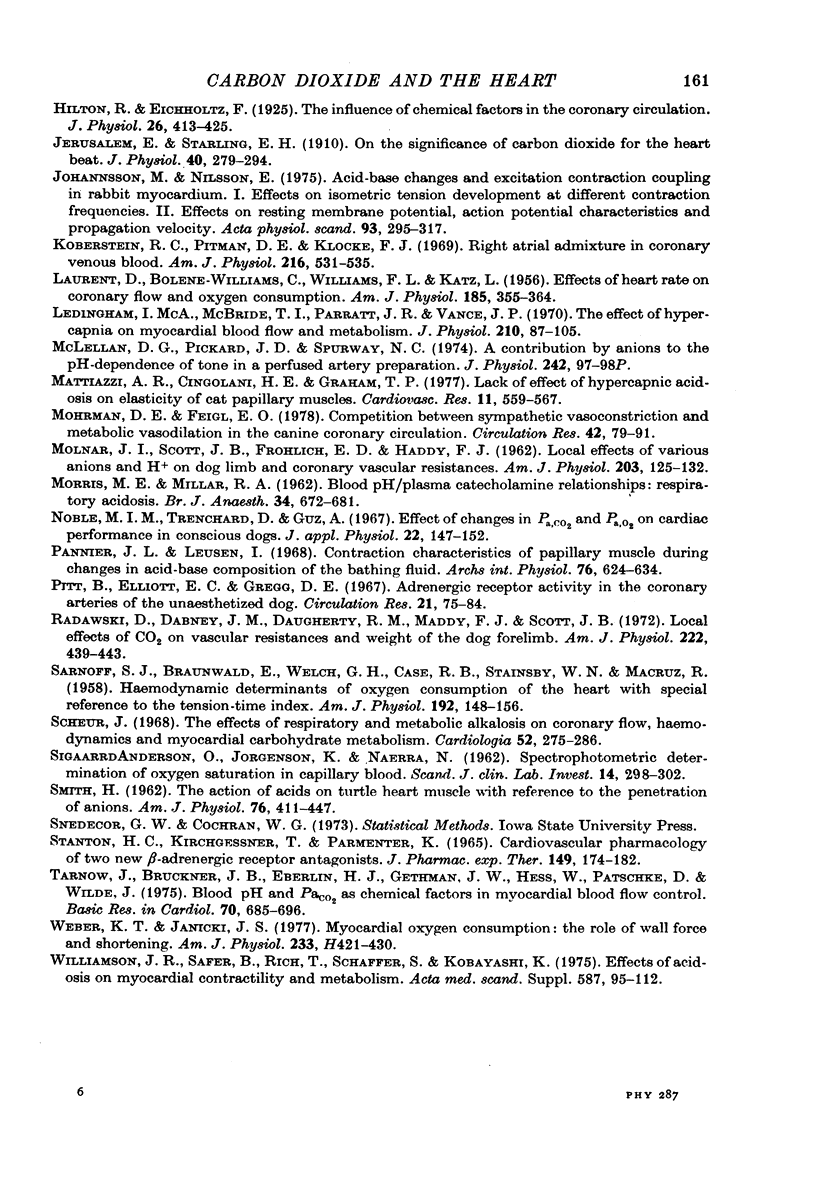
Selected References
These references are in PubMed. This may not be the complete list of references from this article.
- Alexander C. S., Liu S. M. Effect of hypercapnia and hypocapnia on myocardial blood flow and performance in anaesthetized dogs. Cardiovasc Res. 1976 May;10(3):341–348. doi: 10.1093/cvr/10.3.341. [DOI] [PubMed] [Google Scholar]
- Arfors K. E., Arturson G., Malmberg P. Effect of prolonged chloralose anesthesia on acid-base balance and cardiovascular functions in dogs. Acta Physiol Scand. 1971 Jan;81(1):47–53. doi: 10.1111/j.1748-1716.1971.tb04876.x. [DOI] [PubMed] [Google Scholar]
- BARTELS H., HARMS H. Sauerstoffdissoziationskurven des Blutes von Säugetieren (Mensch, Kaninchen, Meerschweinchen, Hund, Katze, Schwein, Rind und Schaf. Pflugers Arch. 1959;268(4):334–365. doi: 10.1007/BF00380734. [DOI] [PubMed] [Google Scholar]
- BERGLUND E., BORST H. G., DUFF F., SCHREINER G. L. Effect of heart rate on cardiac work, myocardial oxygen consumption and coronary blood flow in the dog. Acta Physiol Scand. 1958 Feb 4;42(2):185–198. doi: 10.1111/j.1748-1716.1958.tb01551.x. [DOI] [PubMed] [Google Scholar]
- Buckberg G. D., Luck J. C., Payne D. B., Hoffman J. I., Archie J. P., Fixler D. E. Some sources of error in measuring regional blood flow with radioactive microspheres. J Appl Physiol. 1971 Oct;31(4):598–604. doi: 10.1152/jappl.1971.31.4.598. [DOI] [PubMed] [Google Scholar]
- Case R. B., Felix A., Wachter M., Kyriakidis G., Castellana F. Relative effect of CO2 on canine coronary vascular resistance. Circ Res. 1978 Mar;42(3):410–418. doi: 10.1161/01.res.42.3.410. [DOI] [PubMed] [Google Scholar]
- Case R. B., Greenberg H., Moskowitz R. Alterations in coronary sinus pO2 and O2 saturation resulting from pCO2 changes. Cardiovasc Res. 1975 Mar;9(2):167–177. doi: 10.1093/cvr/9.2.167. [DOI] [PubMed] [Google Scholar]
- Cingolani H. E., Blesa E. S., Gonzalez N. C., Mattiazzi A. Extracellular vs. intracellular pH as a determinant of myocardial contractility. Life Sci. 1969 Jul 1;8(13):775–781. doi: 10.1016/0024-3205(69)90269-0. [DOI] [PubMed] [Google Scholar]
- Cingolani H. E., Mattiazzi A. R., Blesa E. S., Gonzalez N. C. Contractility in isolated mammalian heart muscle after acid-base changes. Circ Res. 1970 Mar;26(3):269–278. doi: 10.1161/01.res.26.3.269. [DOI] [PubMed] [Google Scholar]
- Dennis J., Wyatt D. G. Effect of hematocrit value upon electromagnetic flowmeter sensitivity. Circ Res. 1969 Jun;24(6):875–886. doi: 10.1161/01.res.24.6.875. [DOI] [PubMed] [Google Scholar]
- Dijkema F. K., Elzinga G. Integrator for aortic and pulmonary artery flow signals, with automatic zero adjustment and beat-to-beat mean flow computation. Cardiovasc Res. 1973 Jul;7(4):572–576. doi: 10.1093/cvr/7.4.572. [DOI] [PubMed] [Google Scholar]
- Dijkhuizen P., Buursma A., Fongers T. M., Gerding A. M., Oeseburg B., Zijlstra W. G. The oxygen binding capacity of human haemoglobin. Hüfner's factor redetermined. Pflugers Arch. 1977 Jul 19;369(3):223–231. doi: 10.1007/BF00582188. [DOI] [PubMed] [Google Scholar]
- Domenech R. J., Hoffman J. I., Noble M. I., Saunders K. B., Henson J. R., Subijanto S. Total and regional coronary blood flow measured by radioactive microspheres in conscious and anesthetized dogs. Circ Res. 1969 Nov;25(5):581–596. doi: 10.1161/01.res.25.5.581. [DOI] [PubMed] [Google Scholar]
- Ellis D., Thomas R. C. Direct measurement of the intracellular pH of mammalian cardiac muscle. J Physiol. 1976 Nov;262(3):755–771. doi: 10.1113/jphysiol.1976.sp011619. [DOI] [PMC free article] [PubMed] [Google Scholar]
- FEINBERG H., GEROLA A., KATZ L. N. Effect of changes in blood CO2 level on coronary flow and myocardial O2 consumption. Am J Physiol. 1960 Aug;199:349–354. doi: 10.1152/ajplegacy.1960.199.2.349. [DOI] [PubMed] [Google Scholar]
- Fabiato A., Fabiato F. Effects of pH on the myofilaments and the sarcoplasmic reticulum of skinned cells from cardiace and skeletal muscles. J Physiol. 1978 Mar;276:233–255. doi: 10.1113/jphysiol.1978.sp012231. [DOI] [PMC free article] [PubMed] [Google Scholar]
- Feigl E. O. Sympathetic control of coronary circulation. Circ Res. 1967 Feb;20(2):262–271. doi: 10.1161/01.res.20.2.262. [DOI] [PubMed] [Google Scholar]
- Gonzalez N. C., Cingolani H. E., Mattiazzi A. R., Marsiglia J. C., Serur J. R. Mechanism of action of tris (hydroxymethyl) aminomethane on the negative inotropic effect of carbon dioxide. Circ Res. 1971 Jan;28(1):74–83. doi: 10.1161/01.res.28.1.74. [DOI] [PubMed] [Google Scholar]
- Gregg D. E., Khouri E. M., Donald D. E., Lowensohn H. S., Pasyk S. Coronary circulation in the conscious dog with cardiac neural ablation. Circ Res. 1972 Aug;31(2):129–144. doi: 10.1161/01.res.31.2.129. [DOI] [PubMed] [Google Scholar]
- Hilton R., Eichholtz F. The influence of chemical factors on the coronary circulation. J Physiol. 1925 Mar 31;59(6):413–425. doi: 10.1113/jphysiol.1925.sp002200. [DOI] [PMC free article] [PubMed] [Google Scholar]
- Jerusalem E., Starling E. H. On the significance of carbon dioxide for the heart beat. J Physiol. 1910 May 13;40(4):279–294. doi: 10.1113/jphysiol.1910.sp001370. [DOI] [PMC free article] [PubMed] [Google Scholar]
- Jóhannsson M., Nilsson E. Acid-base changes and excitation-contraction coupling in rabbit myocardium. I. Effects on isometric tension development at different contraction frequencies. Acta Physiol Scand. 1975 Mar;93(3):295–309. doi: 10.1111/j.1748-1716.1975.tb05819.x. [DOI] [PubMed] [Google Scholar]
- Koberstein R. C., Pittman D. E., Klocke F. J. Right atrial admixture in coronary venous blood. Am J Physiol. 1969 Mar;216(3):531–535. doi: 10.1152/ajplegacy.1969.216.3.531. [DOI] [PubMed] [Google Scholar]
- LAURENT D., BOLENE-WILLIAMS C., WILLIAMS F. L., KATZ L. N. Effects of heart rate on coronary flow and cardiac oxygen consumption. Am J Physiol. 1956 May;185(2):355–364. doi: 10.1152/ajplegacy.1956.185.2.355. [DOI] [PubMed] [Google Scholar]
- Ledingham I. M., McBride T. I., Parratt J. R., Vance J. P. The effect of hypercapnia on myocardial blood flow and metabolism. J Physiol. 1970 Sep;210(1):87–105. doi: 10.1113/jphysiol.1970.sp009197. [DOI] [PMC free article] [PubMed] [Google Scholar]
- MOLNAR J. I., SCOTT J. B., FROHLICH E. D., HADDY F. J. Local effects of various anions and H ions on dog limb and coronary vascular resistances. Am J Physiol. 1962 Jul;203:125–132. doi: 10.1152/ajplegacy.1962.203.1.125. [DOI] [PubMed] [Google Scholar]
- MacLellan D. G., Pickard J. D., Spurway N. C. Proceedings: A contribution by anions to the pH-dependence of tone, in a perfused artery preparation. J Physiol. 1974 Oct;242(2):97P–98P. [PubMed] [Google Scholar]
- Mattiazzi A. R., Cingolani H. E., Graham T. P., Jr Lack of effect of hypercapnic acidosis on elasticity of cat papillary muscles. Cardiovasc Res. 1977 Nov;11(6):559–567. doi: 10.1093/cvr/11.6.559. [DOI] [PubMed] [Google Scholar]
- Mohrman D. E., Feigl E. O. Competition between sympathetic vasoconstriction and metabolic vasodilation in the canine coronary circulation. Circ Res. 1978 Jan;42(1):79–86. doi: 10.1161/01.res.42.1.79. [DOI] [PubMed] [Google Scholar]
- Noble M. I., Trenchard D., Guz A. Effect of changes in Pa-CO2 and Pa-O2 on cardiac performance in conscious dogs. J Appl Physiol. 1967 Jan;22(1):147–152. doi: 10.1152/jappl.1967.22.1.147. [DOI] [PubMed] [Google Scholar]
- Pannier J. L., Leusen I. Contraction characteristics of papillary muscle during changes in acid-base composition of the bathing-fluid. Arch Int Physiol Biochim. 1968 Sep;76(4):624–634. doi: 10.3109/13813456809058730. [DOI] [PubMed] [Google Scholar]
- Pitt B., Elliot E. C., Gregg D. E. Adrenergic receptor activity in the coronary arteries of the unanesthetized dog. Circ Res. 1967 Jul;21(1):75–84. doi: 10.1161/01.res.21.1.75. [DOI] [PubMed] [Google Scholar]
- Radawski D., Dabney J. M., Daugherty R. M., Jr, Haddy F. J., Scott J. B. Local effects of CO 2 on vascular resistances and weight of the dog forelimb. Am J Physiol. 1972 Feb;222(2):439–443. doi: 10.1152/ajplegacy.1972.222.2.439. [DOI] [PubMed] [Google Scholar]
- SARNOFF S. J., BRAUNWALD E., WELCH G. H., Jr, CASE R. B., STAINSBY W. N., MACRUZ R. Hemodynamic determinants of oxygen consumption of the heart with special reference to the tension-time index. Am J Physiol. 1958 Jan;192(1):148–156. doi: 10.1152/ajplegacy.1957.192.1.148. [DOI] [PubMed] [Google Scholar]
- Scheuer J. The effects of respiratory and metabolic alkalosis on coronary flow, hemodynamics and myocardial carbohydrate metabolism. Cardiologia. 1968;52(5):275–286. doi: 10.1159/000166128. [DOI] [PubMed] [Google Scholar]
- Stanton H. C., Kirchgessner T., Parmenter K. Cardiovascular pharmacology of two new beta-adrenergic receptor antagonists. J Pharmacol Exp Ther. 1965 Aug;149(2):174–182. [PubMed] [Google Scholar]
- Tarnow J., Brückner J. B., Eberlein H. J., Gethmann J. W., Hess W., Patschke D., Wilde J. Blood pH and PaCO2 as chemical factors in myocardial blood flow control. Basic Res Cardiol. 1975 Nov-Dec;70(6):685–696. doi: 10.1007/BF01906477. [DOI] [PubMed] [Google Scholar]
- Weber K. T., Janicki J. S. Myocardial oxygen consumption: the role of wall force and shortening. Am J Physiol. 1977 Oct;233(4):H421–H430. doi: 10.1152/ajpheart.1977.233.4.H421. [DOI] [PubMed] [Google Scholar]
- Williamson J. R., Safer B., Rich T., Schaffer S., Kobayashi K. Effects of acidosis on myocardial contractility and metabolism. Acta Med Scand Suppl. 1976;587:95–112. doi: 10.1111/j.0954-6820.1976.tb05871.x. [DOI] [PubMed] [Google Scholar]


